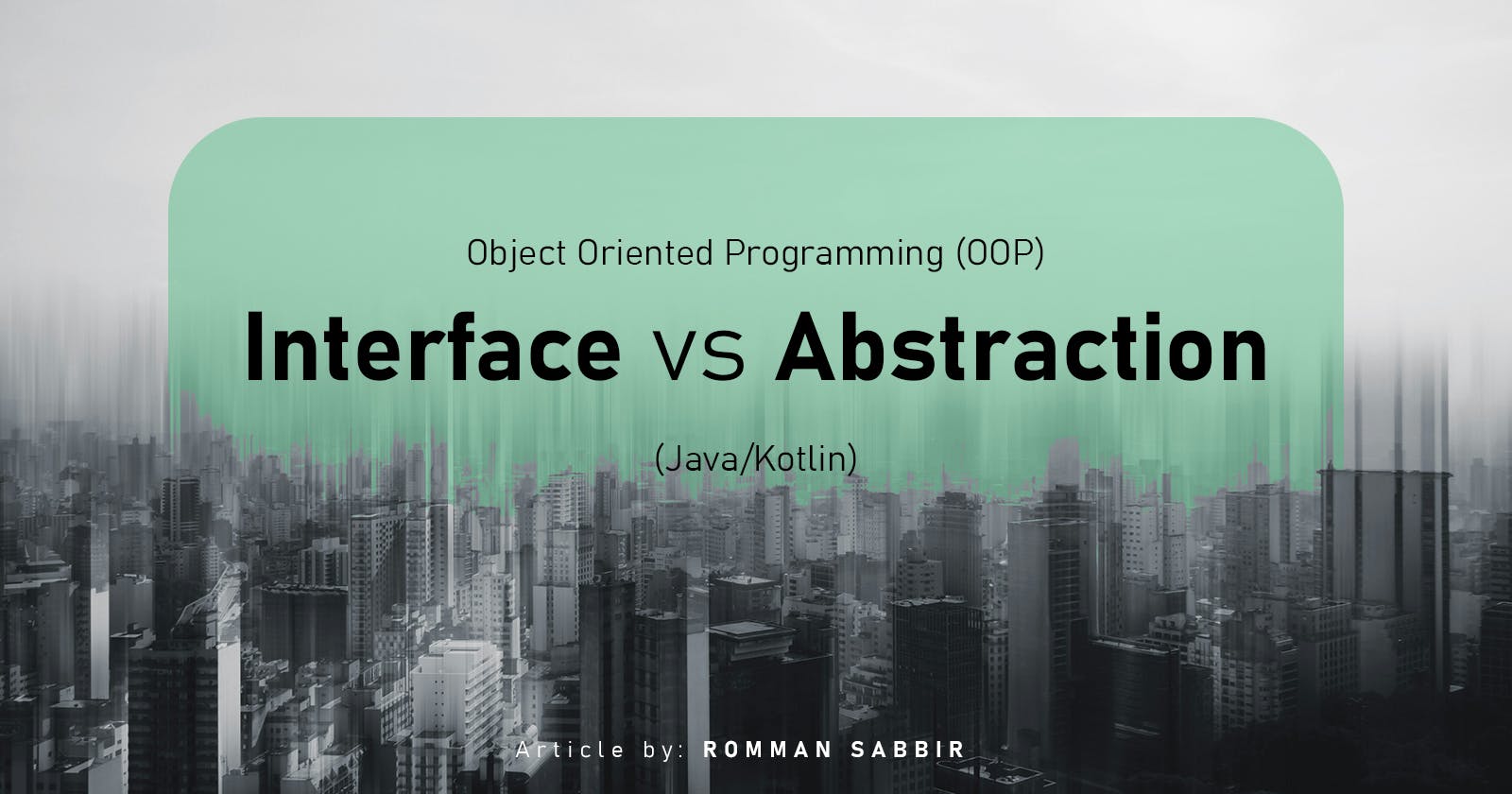Object Oriented Programming (OOP) - Interface vs Abstraction (Java/Kotlin)
Understanding Interface vs Abstraction: A Comprehensive Guide with Java/Kotlin.
[Cover Image by : Rafael de Nadai]
In the world of programming, two key concepts often come up: Interface and Abstraction. Both are fundamental to object-oriented programming (OOP) and play crucial roles in designing robust and maintainable software systems.
In this article, we'll understand the differences between Interface and Abstraction, explore various scenarios where they are used, and provide examples in both Kotlin and Java.
Key differences between Interface and Abstraction:
| Aspect | Interface | Abstraction |
| Definition | Specifies a set of methods that a class must implement. | Hides the implementation details and provides a common interface. |
| Implementation | Implemented by classes using the implements keyword. | Implemented by abstract classes using the abstract keyword. |
| Multiple | Supports multiple inheritance. | Supports single inheritance. |
| Members | Can contain only method signatures and constants. | Can contain both method declarations and concrete methods. |
| Purpose | Defines a contract for classes to adhere to. | Provides a blueprint for subclasses to follow. |
Now, let's explore scenarios where each concept shines.
Usage Scenarios:
Interface:
Plugin Architecture: Imagine we're building a text editor application that supports various plugins for different functionalities like syntax highlighting, spell checking, and auto-completion. By defining interfaces like
SyntaxHighlighter,SpellChecker, andAutoCompleter, we can ensure that any plugin adhering to these interfaces seamlessly integrates with our editor.interface SyntaxHighlighter { fun highlight(text: String): String } // Usage class JavaSyntaxHighlighter : SyntaxHighlighter { override fun highlight(text: String): String { // Implement Java syntax highlighting } }interface SpellChecker { boolean check(String text); } // Usage class EnglishSpellChecker implements SpellChecker { @Override public boolean check(String text) { // Implement English spell checking } }Testing Frameworks: When building test suites, interfaces are must. For instance, in a unit testing framework, we might define an interface
Testwith a methodrun()to execute the test cases. This allows different types of tests (e.g., unit tests, integration tests) to be executed uniformly.interface Test { fun run(): Boolean } // Usage class UnitTest : Test { override fun run(): Boolean { // Implement unit test logic } }
Abstraction:
Vehicle Simulation: Let's say we're simulating a traffic system where various vehicles operate. We could have an abstract class
Vehiclewith common attributes and methods such asaccelerate()andbrake(). Each specific vehicle type, likeCarorTruck, extends this abstract class and provides its implementation.abstract class Vehicle { var speed: Double = 0.0 abstract fun accelerate() abstract fun brake() } // Usage class Car : Vehicle() { override fun accelerate() { // Implement car acceleration } override fun brake() { // Implement car braking } }abstract class Vehicle { double speed = 0.0; abstract void accelerate(); abstract void brake(); } // Usage class Car extends Vehicle { @Override void accelerate() { // Implement car acceleration } @Override void brake() { // Implement car braking } }Shape Hierarchy: Consider a scenario where we're modeling different shapes in a graphics application. We can create an abstract class
Shapewith methods likecalculateArea()anddraw(). Concrete shape classes likeCircleorRectangleextend this abstract class and provide their specific implementations.abstract class Shape { abstract fun calculateArea(): Double abstract fun draw() } // Usage class Circle : Shape() { override fun calculateArea(): Double { // Implement circle area calculation } override fun draw() { // Implement circle drawing } }abstract class Shape { abstract double calculateArea(); abstract void draw(); } // Usage class Circle extends Shape { @Override double calculateArea() { // Implement circle area calculation } @Override void draw() { // Implement circle drawing } }
Conclusion:
In summary,
While both Interface and Abstraction are essential concepts in OOP, they serve distinct purposes. Interfaces define contracts for classes to adhere to, facilitating polymorphism and code re-usability. On the other hand, abstractions hide implementation details and provide blueprints for sub-classes to follow, promoting code organization and maintainability.
Understanding when and how to use each concept is crucial for building scalable and maintainable software systems. By leveraging Interface and Abstraction effectively, developers can design robust, flexible, and modular applications.
That's it for today. Happy coding...

